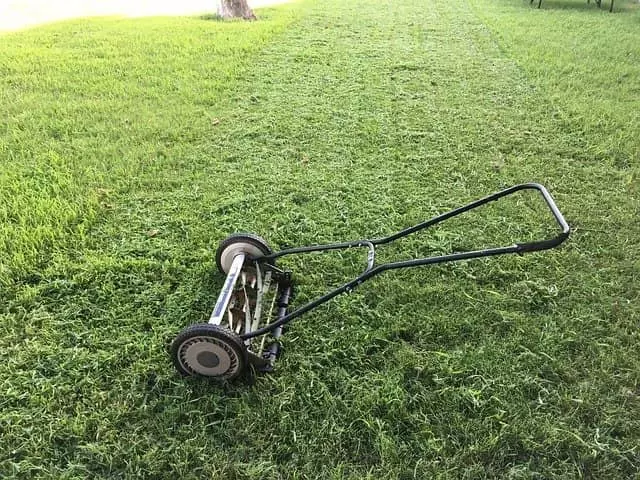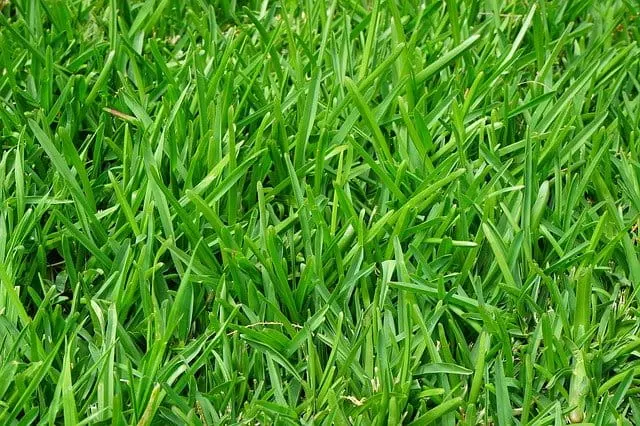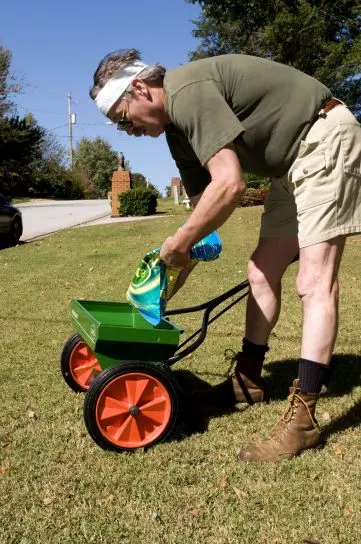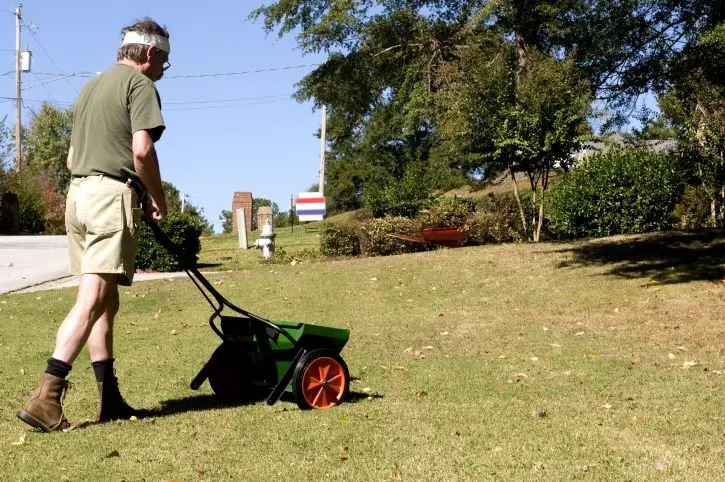Just as a person needs minerals and vitamins to live, the natural lawn also needs nutrients for its development. That is why in this article we will explain everything about how to fertilize lawn correctly.
Plants do not need complex compounds, such as vitamins or amino acids, essential in human nutrition, because they synthesize all those they need. They only require a dozen chemical elements, which must be in a form that the plant can absorb.
Among the necessary nutrients, air and water provide hydrogen, oxygen, and carbon in inexhaustible quantities. Almost all soils contain an abundance of sulfur, calcium, iron, and other essential nutrients.
Calcium is often added to the soil, but its primary function is to reduce acidity, not to act as a fertilizer in the strict sense. Nitrogen is present in the atmosphere in enormous quantities, but plants cannot use it in this way; certain bacteria provide plants with the necessary nitrogen, which they take from the air and transform it through a series of reactions called “nitrogen fixation”.
The three elements that almost all fertilizers must contain are nitrogen, phosphorus, and potassium. Occasionally, small amounts of some others, including boron, copper, and manganese, must be added to these.
For a green, lush, healthy, weed-free natural lawn, you will need to know the nutritional needs of your lawn and apply for the correct fertilization program. To do this you will need to determine what variety of grass you have, what properties the soil has, and when and how you should apply fertilizer.
Table of Contents
Why Is It Necessary to Fertilize Your Lawn?
Not all soils provide the necessary nutrients for a healthy lawn, and even nutrient-rich soils can deplete over time. Lawns are heavy consumers of nutrients and require regular replenishment for optimal growth. Fertilizers, along with proper irrigation and mowing, are essential for maintaining a healthy lawn. Here are the key reasons why fertilizing your lawn is necessary:
- Nutrient Deficiency in Soil: Sandy soils often have low nutrient content and can lose nutrients quickly due to water drainage.
- Recovery from Mowing: Regular mowing depletes nutrients in the grass. Fertilization helps replenish these nutrients, aiding in the lawn’s recovery and growth.
- Resilience Against Damage: Fertilizers help lawns recover from trampling and damage caused by diseases, insects, and fungi. They also strengthen the grass, making it more resistant to future attacks.
- Promotes Growth: Fertilizers stimulate both leaf and root growth, ensuring a lush and healthy lawn.
- Replenishes Lost Nutrients: Nutrients are lost through processes such as filtration, volatilization, removal of grass clippings, and the lawn’s natural consumption. Fertilization replenishes these lost nutrients.
- Weed Control: A well-fertilized lawn can reduce and control the growth of weeds by promoting dense grass coverage, which crowds out weeds.
- Prevents Chlorosis: Lawns with low nitrogen levels can develop chlorosis (yellowing), resulting in low plant mass and density. Fertilization helps maintain adequate nitrogen levels, preventing chlorosis and promoting a dense, green lawn.

Steps Before Fertilizing Lawns
To determine the appropriate type and quantity of fertilizer for your lawn, follow these recommendations:
- Test the Soil: Knowing the pH of your soil is crucial. Depending on whether the soil is very high (alkaline) or low (acidic), you will need a specific type of fertilizer. The ideal pH level for most lawns is around 6.5, but a range of 5.5 to 8 is generally acceptable. Consider using a soil pH meter to test your soil (you can order one here). Learn more about how to measure soil pH.
- Identify the Lawn Variety: Different varieties of lawns may require different fertilizers. While this isn’t always the case, it’s helpful to know your lawn type to select the most suitable fertilizer.
- Calculate the Lawn Area: Measure the total area of your lawn. Knowing the exact size will help you determine how much fertilizer you need to apply for effective coverage.
- Kindly NOTE: This soil tester can not be applied to test pH value of any other liquid. If the soil is too dry the indicator will not move, and water it before testing.
Types of Lawn Fertilizers
Lawn fertilizers come in various forms and presentations. Let’s categorize them based on their state or form:
Liquid Fertilizers
They are fast-acting. Penetrate the soil and quickly reach the roots. They are usually mixed with water, using applicators that are attached to the hose or automatic irrigation system. Because it is absorbed so quickly, it is necessary to apply it every 2 / 3 weeks.
Granular Fertilizers
They are applied broadcast or with a spreader for large surfaces. They need to be watered for their dissolution and penetration into the soil. Their application is easy to control since we know at all times when and how much fertilizer each zone receives. Granular fertilizers can be slow-release or fast release:
Slow-Release Granular Lawn Fertilizer
Releases nutrients little by little, gradually according to the needs of the plant. Thus, there is less loss of nutrients by washing and evaporation. Some act for ± 8 weeks (they are coated by a sulfur layer) and others act for ± 12 weeks (they are coated by a polymer layer).
Advantages:
- Nourishes properly over a long period, adapting to the needs of the lawn.
- Avoids excessive growth of the lawn, since the element that causes it, Nitrogen (N), is released slowly.
- Reduced loss of nutrients through water (leaching) and evaporation.
- Reduced risk of burns.
Fast Release Granular Lawn Fertilizer:
Releases nutrients in ± 4 weeks.
All of the above times vary depending on the receiving water and temperature.
Some fertilizers combine an herbicidal action while nourishing. They are of two types:
Pre-emergent:
It is applied in early spring before the weeds emerge since once they germinate the herbicide does not affect them.
Post-emergent:
It is a contact fertilizer herbicide and is only effective against weeds that have started to grow, not against weeds that have not yet germinated.

Symbology To Understand Fertilizer Composition
Fertilizers are a compound of different chemical elements and proportions. Once the needs of the lawn in terms of nutrients have been determined, it is necessary to choose the appropriate fertilizer.
If you are not familiar with the chemical terminology of fertilizers, here are the keys to understand what they contain.
The chemical elements are represented by one or two letters to simplify their inscription. The 3 most important not only for lawns but for any plant are Nitrogen, Phosphorus, and Potassium.
- Nitrogen – N: It favors the development of the leaves and provides the bright green color and is the most abundant element in the plant, it constitutes ± 4 % of the plant.
- Phosphorus – P: Helps root development.
- Potassium – K: Helps root development and provides resistance to diseases, drought, and intense cold.
- Calcium – Ca: For root development.
- Magnesium – Mg: For the formation of sugars, an essential component of plant tissue.
- Sulfur – S: To enhance greenness. Mixed with lime, it has a fungicidal action.
- Zinc – Zn: It participates as an enzymatic cofactor in many metabolic processes of plants, including the creation of the vital hormone for the growth and development of the lawn. It is also essential for nitrogen metabolism and protein synthesis.
- Iron – Fe: Fundamental element for growth, since it is a component of chlorophyll and proteins. It is one of the micronutrients that are needed in greater quantities. Its deficiency is denoted in yellowish lawns.
- Manganese – Mn: Together with iron, it improves photosynthesis.
- Copper – Cu
- Molybdenum – Mo
Interpretation Of the Fertilizer Formula
In many bags, sacks and cans we will find a formula similar to this one: 20 – 10 – 5.
This formula means that the composition of the fertilizer has the following elements:
20 % Nitrogen.
10 % of Phosphorus.
5 % of Potassium.
The first figure will always correspond to Nitrogen, the second figure will always correspond to Phosphorus and the third figure will always correspond to Potassium.
Which Lawn Fertilizer to Use?
It depends on the type of lawn, soil, the season, climate, what the lawn is used for. Here are some examples:
For ornamental lawns like those featuring fine Agrostis species, apply a balanced fertilizer with a composition such as 15-15-15.
- Mid-Spring and Early Fall: Apply 1.7 ounces (50 grams) per 10 square feet (square meter).
- Mid-Summer: Apply a lighter dose of 1 ounce (30 grams) per 10 square feet (square meter) to prevent stress during hotter months.

Adequate Amount of Fertilization
It depends on the composition of the fertilizer and the way it acts (slow or fast release of nutrients). Always follow the manufacturer’s instructions.
These are the following lawn fertilizers that we recommend:
We can say that in general, a natural lawn needs about 2.6 lbs (1.2 kg) of nitrogen per 1076.39 ft² (100 m²) per year, distributed 3 times a year. This means that of a fertilizer with a composition, for example, of 20-4-10, and knowing that figure 20 means 20% of Nitrogen per 220 lbs (100 kg) of fertilizer, we will have to apply a total of 13 lbs (6 kg) of this fertilizer per year to provide the recommended 2.6 lbs (1.2 kg) of Nitrogen. A simple rule of three is enough to know the amount of fertilizer to use.
When to Fertilize Lawn – Frequency of Fertilization
Fertilize when the natural lawn is in its growing season. Fertilizing during dormant periods such as cold or hot weather will not make the lawn grow more.
Cool Season Lawns
Fall: Fertilize generously when the heat has subsided.
Spring: Fertilize very lightly early in the season, either with a slow or fast release fertilizer, but have it take effect before the arrival of high heat.
Warm-Season Lawns
Spring: Fertilize when greening begins, either with a fast or slow-release fertilizer, but make sure it takes effect before summer. With the arrival of intense heat, stop fertilizing.
Autumn: Fertilize when the intense heat has subsided.
These are general recommendations. Follow the specific instructions of each fertilizer. Too little fertilizer will have little effect on the lawn, and too much will burn the lawn. Also, do not fertilize in intense heat or cold as this can damage the lawn.
Slow-release fertilizers can be used twice a year, once at the end of summer, when the excessive heat subsides, approximately at the beginning of September (depending on the area), and once at the end of winter when the cold subsides, approximately at the beginning of March.
How to Fertilize Lawn
In general, it is necessary to avoid concentrations of fertilizer when applying it so that the lawn does not burn. The normal method is manually (broadcasting), but if the lawn is very large you can acquire a tool to facilitate the task. It is also necessary to water abundantly once the fertilizer has been applied so that it dissolves and penetrates the soil and does not burn the plant.
It is advisable to fertilize one day after mowing.
Here are some tools that will help you fertilize your lawn more easily.
Fertilizer should not be applied when the lawn is wet or damp as it will stick to the blades and burn them.

Granular Fertilizer:
Both the applicator and the fertilizer must be dry.
Whether you use an applicator or broadcast, to make the fertilizer distribution as uniform as possible, divide the amount to be applied in two halves and spread it in two passes in a criss-cross manner, i.e., one pass horizontally and one vertically.
Clean the spreader thoroughly after use.
Liquid Fertilizer:
Move the jet of the applicator with lateral passes, slowly and with a constant rhythm.
Clean the applicator well after use.
We hope this complete guide on how to fertilize your lawn will be very useful and that you will have the best lawn in your garden.










